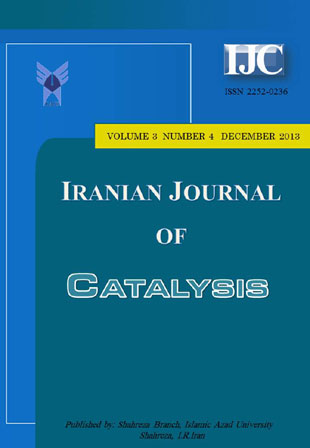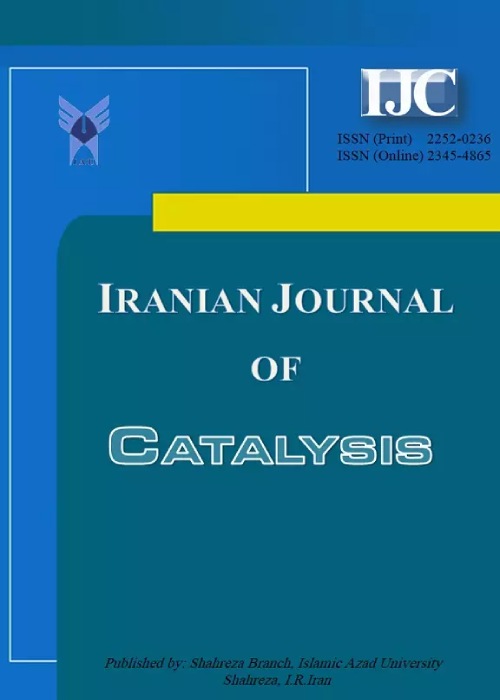فهرست مطالب

Iranian Journal of Catalysis
Volume:3 Issue: 4, Autumn 2013
- تاریخ انتشار: 1392/09/25
- تعداد عناوین: 10
-
-
Pages 191-196In this research, we have developed cheap recyclable and task-specific acidic ionic liquids (AILs) 1-hydrogen-3-methylimidazolium hydrogen sulfate [Hmim]HSO4, 1-hydrogen-3-methylimidazolium chloride [Hmim]Cl, 2-pyrrolidonium hydrogensulfate [Hnhp]HSO4 and applied them in acid catalyzed synthesis of quinoxaline derivatives from 1,2-phenylendiamines and 1,2-dicarbonyl compounds. The products could be separated from the catalyst simply by filtration and the catalyst could be recycled and reused several times without noticeable loss of efficiency.Keywords: Acidic Ionic liquid, AILs, Quinoxaline, Green chemistry, Room temperature
-
Pages 197-201p-Dodecylbenzenesulfonic acid (DBSA) was used as a catalyst for a simple and efficient one-pot synthesis of aryl substititued tetrahydrobenzo[b]pyrans and dihydropyrano[c]chromens via initial Knoevenagel, subsequent Micheal and final heterocyclization reactions of aryl aldehyde, malononitrile and 4-hydroxycoumarin/dimedone in moderate to excellent yields. The present method was operationally simple and use of water as the reaction medium made the process environmentally benign. Article keywords:.Keywords: Green media, Dihydropyrano[c]chromen, p, Dodecylbenzenesulfonic acid (DBSA), Tetrahydrobenzo[b]pyran
-
Pages 203-209Decatungstodivanadogermanic acid (H6GeW10V2O40.22H2O) was used as a green heterogeneous catalyst for the synthesis of 3,4-dihydropyrimidin-2-(1H)-ones from one-pot three-component cyclocondensation reaction of a β-ketoester, an aldehyde and urea/thiourea under solvent-free conditions is reported. This method provides an efficient and much improved modification of the original Biginelli reaction reported in 1893, in terms of high yields, and short reaction times. It has the ability to allow a wide variety of substitutions in all three components.Keywords: Biginelli reaction, Heteropolyacid, Decatungstodivanadogermanic acid, 3, 4, dihydropyrimidin, 2, (1H), ones, thiones, Heterogeneous catalysis
-
Pages 211-220Melamine trisulfonic acid (MTSA) as an efficient heterogeneous catalyst has been used for the one-pot preparation of triazolo [1،2-a] indazole-1،3،8-trione and 2H-indazolo [2،1-b] phthalazine-1،6،11-trione derivatives by the three-component condensation reaction of urazoles or phthalhydrazide، dimedone or 1،3-cyclohexanedione، and aldehydes under solvent-free conditions in good to excellent yields and short reaction times.Keywords: Multi, component reaction, Melamine trisulfonic acid (MTSA), Urazole, Dimedone, 1, 3, cyclohexanedione, Aldehyde, Phthalhydrazide
-
Pages 221-228Silica-bonded n-propyltriethylene-tetramine (SBNPTT) was found as an efficient solid base for the synthesis of 2-amino-5-oxo-5,6,7,8-tetrahydro-4H-chromenes. Chromene derivatives were obtained via the three-component condensation reaction of aromatic aldehydes, malononitrile, and dimedone at 80 oC under solvent-free conditions. The heterogeneous solid base showed much the same efficiency when used in consecutive reaction runs.Keywords: Silica, bonded n, propyltriethylene, tetramine, Chromenes, Solid bases, Catalyst, Synthesis
-
Pages 229-235Regarding the green chemistry''s goals, dicationic magnetic room temperature ionic liquid open up new avenue to introduce an amazing and efficient system for facilitating catalyst recovery in different organic reactions. Ability of this dicationic magnetic room temperature ionic liquid catalyst in the one-pot three-components condensation reaction of benzil, aromatic aldehyde, and ammonium acetatate are also described. Utilization of easy reaction conditions, catalyst with high catalytic activity and good reusability, and simple magnetically work-up, makes this methodology as an interesting option for the synthesis of 2,4,5-trisubstituted imidazoles.Keywords: One, pot synthesis, 2, 4, 5, Trisubstituted imidazole, Dicationic magnetic ionic liquid, Solvent, free
-
Pages 237-242A simple and environmentally benign procedure for the synthesis of 14-aryl-14H-dibenzo[a,j]xanthenes by a one-pot condensation of 2-naphthol with aromatic aldehyde in the presence of [Et3NH][HSO4] as an acidic ionic liquid catalyst under solvent-free conditions has been developed. The reaction work-up is very simple and the catalyst can be easily separated from the reaction mixture and reused several times in subsequent reactions.Keywords: 14, Aryl, 14H, dibenzo[a, j]xanthenes, [Et3NH][HSO4], Solvent, free conditions, 2, Naphthol, Aldehyde
-
Pages 243-247Methanesulfonic acid (MSA) was found to be an efficient catalyst for the synthesis of 1-substituted-1H-1,2,3,4-tetrazoles. A series of 1-substituted tetrazole compounds were synthesized from the reaction of various primary amines, sodium azide and triethyl orthoformate in the presence of catalytic amounts of MSA at room temperature. In this protocol, some of the tetrazole derivatives were synthesized in good to excellent yields and convenient reaction times. This method has the advantages of simple methodology and easy work-up.Keywords: 1H, Tetrazoles, Methanesulfonic acid, Solvent, free, Room temperature, Primary amines
-
Pages 249-259
-
Pages 251-253


